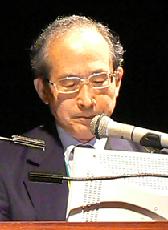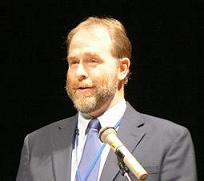|
|
Vol.
29 No. 1
January-February 2007
Pesticide
Chemistry
by
Ken Racke
The 11th IUPAC International Congress of Pesticide Chemistry
was held 6–10 August 2006 in Kobe, Japan. This long-standing
conference was established more than 40 years ago, and the
meeting in Kobe marked the first return to Japan since 1982.
The congress was organized under the auspices of the IUPAC
Division on Chemistry and Environment (VI) and the Pesticide
Science Society of Japan (PSSJ), and the meticulous planning
and flawless execution were in large measure due to the strong
leadership provided by key members of PSSJ, including Organizing
Chairman Hideo Ohkawa, Organizing Vice-Chairman Isao Ueyama,
PSSJ President Ken Umetsu, Scientific Committee Chairman Hisashi
Miyagawa, and Chief Secretariat Mitsuru Sasaki.
 |
|
Hideo
Ohkawa during the Opening ceremony
|
More
than 1 100 chemists from 52 countries participated in the
congress, which was organized around the theme “Evolution
for Crop Protection, Public Health, and Environmental Safety.”
The core of the scientific program consisted of welcoming
speeches on behalf of PSSJ and IUPAC, 5 keynote addresses,
more than 100 invited lectures, and nearly 600 posters. All
the traditional technical strengths of past congresses were
well represented by posters and lectures distributed among
such main topics as new chemistry, natural products, biopesticides
and transgenic crops, mode of action and resistance, environmental
chemistry and analysis, metabolism and toxicology, and risk
assessment and regulation. The broad range of interests was
exemplified by the topics selected for the keynote addresses:
- James
Collins, DuPont, USA, “Challenges and Opportunities
in Crop Protection over the Next Decade”
- Kenji
Mori, University of Tokyo, Japan, “Searching for Environmentally
Benign Methods for Pest Control — Reflections of a
Synthetic Chemist”
- Shivaji
Pandey, FAO, Italy, “Hunger and Malnutrition Amidst
Plenty — What Must be Done?”
- Yang
Yongzhen, Institute for the Control of Agrochemicals, Ministry
of Agriculture, China, “The Current Status of Pesticide
Regulation and Management in China”
- Ken
Racke, IUPAC, USA, “Safety Assessment
and International Trade Implications of Pesticide
Residues in Food”.
 |
|
Ken
Racke
|
The
value of the conference’s large poster sessions was enhanced
by the organization of 15 topical poster workshops during
which selected poster authors were invited to briefly note
major points of their research, following which an open discussion
occurred. The innovative nature of the research and high quality
of the poster presentations was recognized through a series
of gold, silver, and bronze awards that were presented across
three categories. In addition, a special poster award recognizing
outstanding research in scientifically emerging countries
was presented for each of the three categories. The Poster
Award Committee was chaired by John Unsworth of the IUPAC
Division VI Advisory group on Crop Protection Chemistry and
included several members of the Division VI Committee. Financial
sponsorship for the poster awards was provided by Bayer CropScience.
Gold award winners received an IUPAC certificate and a 100
000 Yen prize. The top awardees and their poster topics are
listed below:
- Naoya
Ichimaru, Kyoto University, Japan, “Alacacetogenins
Are a New Class of Inhibitors of Mitochondrial Complex I”
-
Neil Millar, University College of London, UK and Zewen
Liu, Nanjing Agricultural University, China, “A Nicotinic
Acetylcholine Receptor Point Mutation Conferring Insecticide
Resistance Causes Reduced Agonist Potency to a Range of
Neonicotinoids”
- Yumi
Akiyama, Hyogo Prefecture Institute of Public Health and
Environmental Science, Japan, “Multiresidue Analysis
of 500 Pesticides in Agricultural Products Using GC/MS and
LC/MS”
|
|
Gold
medal poster winner Neil Millar (3rd from left) offering
his thanks on behalf of all awardees during the ceremony
of the 11th
IUPAC International Congress of Pesticide Chemistry
held 6-10 August 2006, in Kobe, Japan. Poster Award
Committee Chair John Unsworth of IUPAC is at the far
right.
|
One
innovation incorporated into the programming for Kobe involved
28 seminars organized around luncheons (18) or dinners (10).
Each of these one-hour sessions was sponsored by a company,
government institute, or scientific association that provided
a meal to participants and organized a lecture, discussion,
or demonstration topic of their choosing. Between 100 and
240 individuals attended each seminar and the events were
quite popular among the attendees, both for the interesting
technical aspects and free meals. The topics of these sessions
were as diverse as the hosting organizations, and examples
of sponsors included the Fraunhofer Institute, Sumitomo Chemical,
Immunochemical Society of Japan, IUPAC, and the U.S. Department
of Agriculture.
Pesticide
chemistry plays an important role in crop protection and agricultural
production. This role has been the foundation for many of
the main topics that have comprised the IUPAC Congress of
Pesticide Chemistry over the years. As reflected by the conference
theme, the Kobe Congress organizers also chose to emphasize
the role and importance of pesticides in public health protection
and disease vector control. Lecture and poster sessions were
organized around the topic of vector control chemistry, and
a poster workshop discussion was devoted to the specific topic
of mosquito control. A luncheon seminar featured Pierre Guillet,
director of the World Health Organization’s Global Malaria
Program, who explained the increasingly important role of
insecticide treated bednets.
In
addition to the academic research community, government regulators
and industry were also well represented in the congress program.
For example, invited lecturers included top regulatory officials
from the Japan Ministry of Health, Labor, and Welfare; Japan
Ministry of Agriculture, Fisheries, and Forestry; U.S. EPA
Office of Pesticide Programs; Chinese Ministry of Agriculture;
German Office of Consumer Protection; and Thailand Ministry
of Public Health. Industry participation was strong via the
technical program of lectures and posters, a healthy commercial
exhibition (56 booths), and luncheon and evening seminars.
As part of the technical program, a “Research Director
Forum” was also organized that focused on industrial
R&D success stories and future directions for crop protection
chemistry. This first-ever event for the congress series began
with short speeches by each of the VP-research directors of
the most important agrochemical companies (Bayer, BASF, Dow,
DuPont, ISK, Sumitomo, and Syngenta) and was followed by a
lively panel discussion.
The
Congress organizers made unique efforts to educate the broader
public regarding crop protection chemistry and its value to
modern society.
Approximately
370 members of the public, consumer groups, and news media
participated in an open seminar (in Japanese), which featured
Masuru Kitano of Meiji University and emphasized the role
and importance of contemporary pesticide technologies. Members
of the news media were invited to the opening ceremonies and
a subsequent press conference that featured key members of
the organizing committee. As a result of these efforts, public
awareness of the IUPAC Congress and the importance of pesticide
chemistry were raised through several feature articles that
appeared in Japanese newspapers and a report on the morning
news of Japanese TV station NHK.
IUPAC
members played important roles in the planning and execution
of the congress, and served prominently on the Congress Advisory
Board and the Scientific Program Committee, as session chairs,
and invited lecturers. The IUPAC poster awards recognized
outstanding poster contributions. An IUPAC booth was developed
for the exhibition to display informational materials and
highlight crop protection chemistry-related projects. Two
IUPAC projects that are nearing completion sponsored seminars
as a means of disseminating conclusions and recommendations.
These included a seminar on “Global Availability of Information
on Agrochemicals” (1) and a seminar on “Impact of
Transgenic Crops on the Use of Agrochemicals and the Environment.”
(2) The IUPAC Division of Chemistry and the Environment helped
fund the attendance of chemists from scientifically emerging
countries.
Further
information on the recently concluded congress,including abstracts
and a colorful newsletter that was published each day of the
congress (The Kobe Gazette), is available via the congress
website at <www.iupac2006.jtbcom.co.jp>.
The Congress proceedings, to include keynote addresses and
invited lectures, will be produced by Wiley-VCH, with a target
publication date of March 2007. The 12th IUPAC International
Congress of Pesticide Chemistry is being organized in cooperation
with the Royal Australian Chemical Institute for July 2010
in Melbourne, Australia. Information on future plans will
be available at the congress website <www.raci.org.au/iupacicpc2010>.
IUPAC
Project References
1 John B. Unsworth, <www.iupac.org/projects/2001/2001-022-1-600.html>
2 Gijs A. Kleter, <www.iupac.org/projects/2001/2001-024-2-600.html>
Ken Racke <[email protected]>,
a global regulatory leader with Dow AgroSciences in Indianapolis,
Indiana, USA, is president of the IUPAC Division of Chemistry
and the Environment.
Page
last modified 25 January 2007.
Copyright © 2003-2007 International Union of Pure and
Applied Chemistry.
Questions regarding the website, please contact [email protected]
|